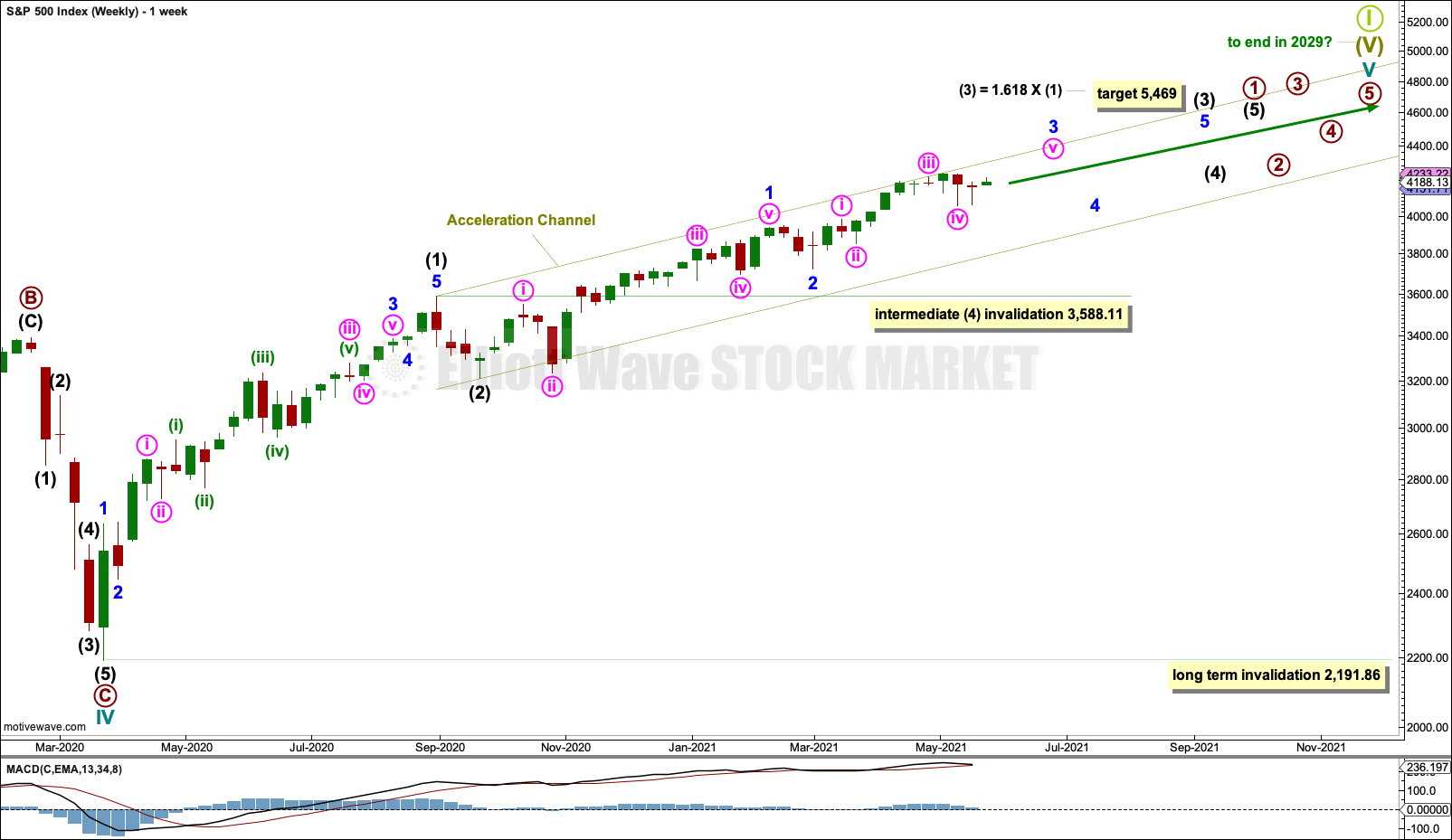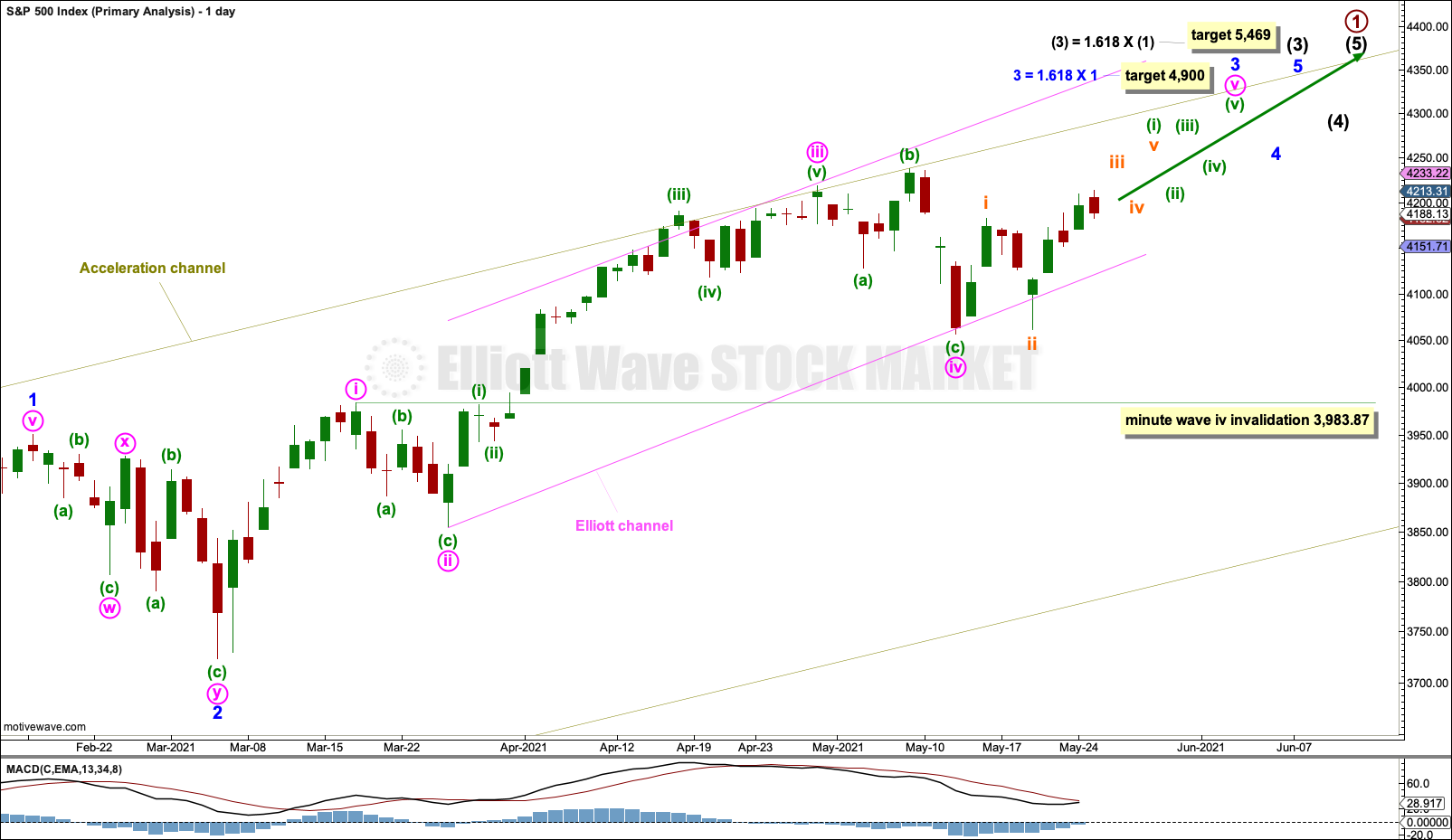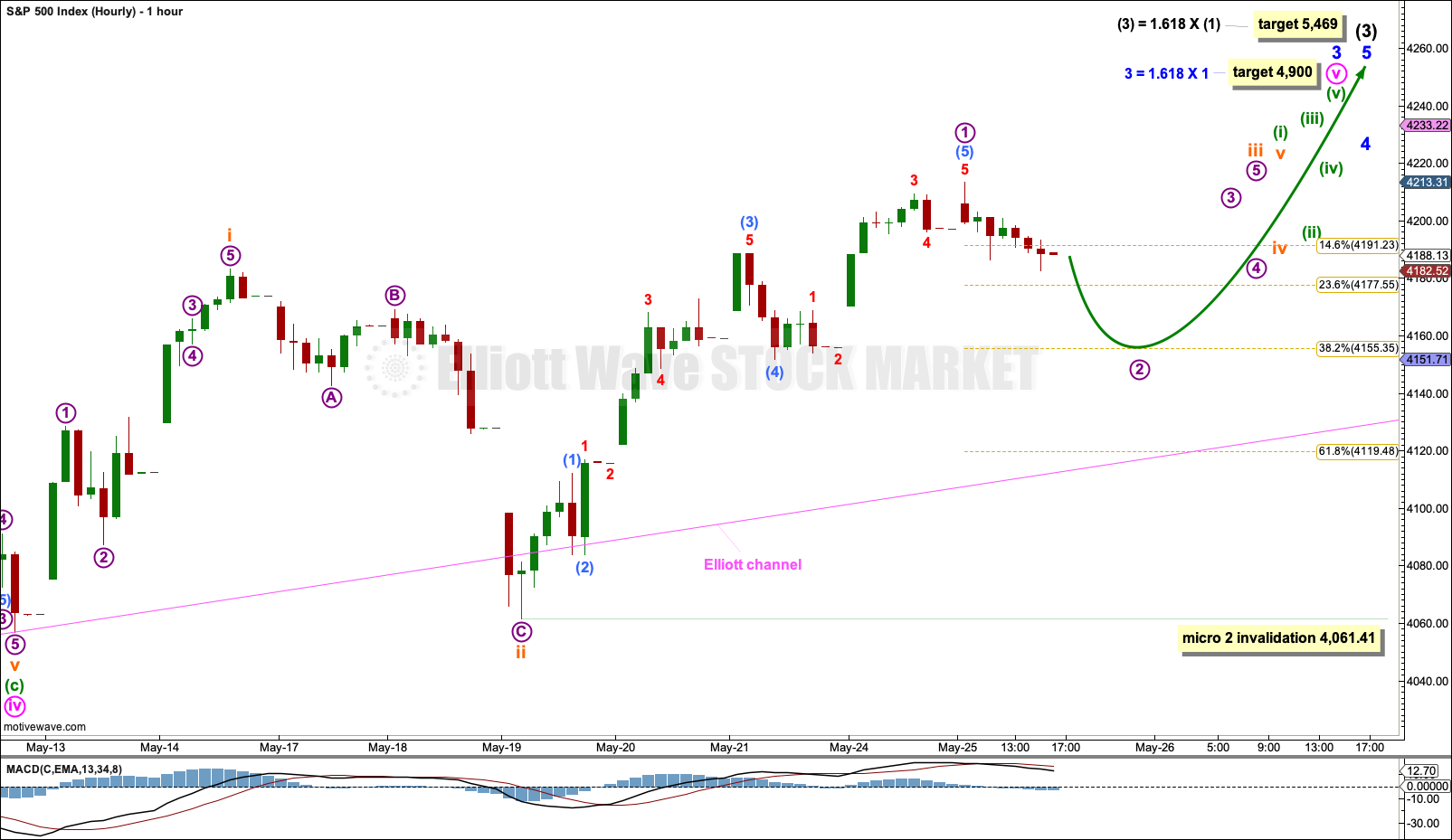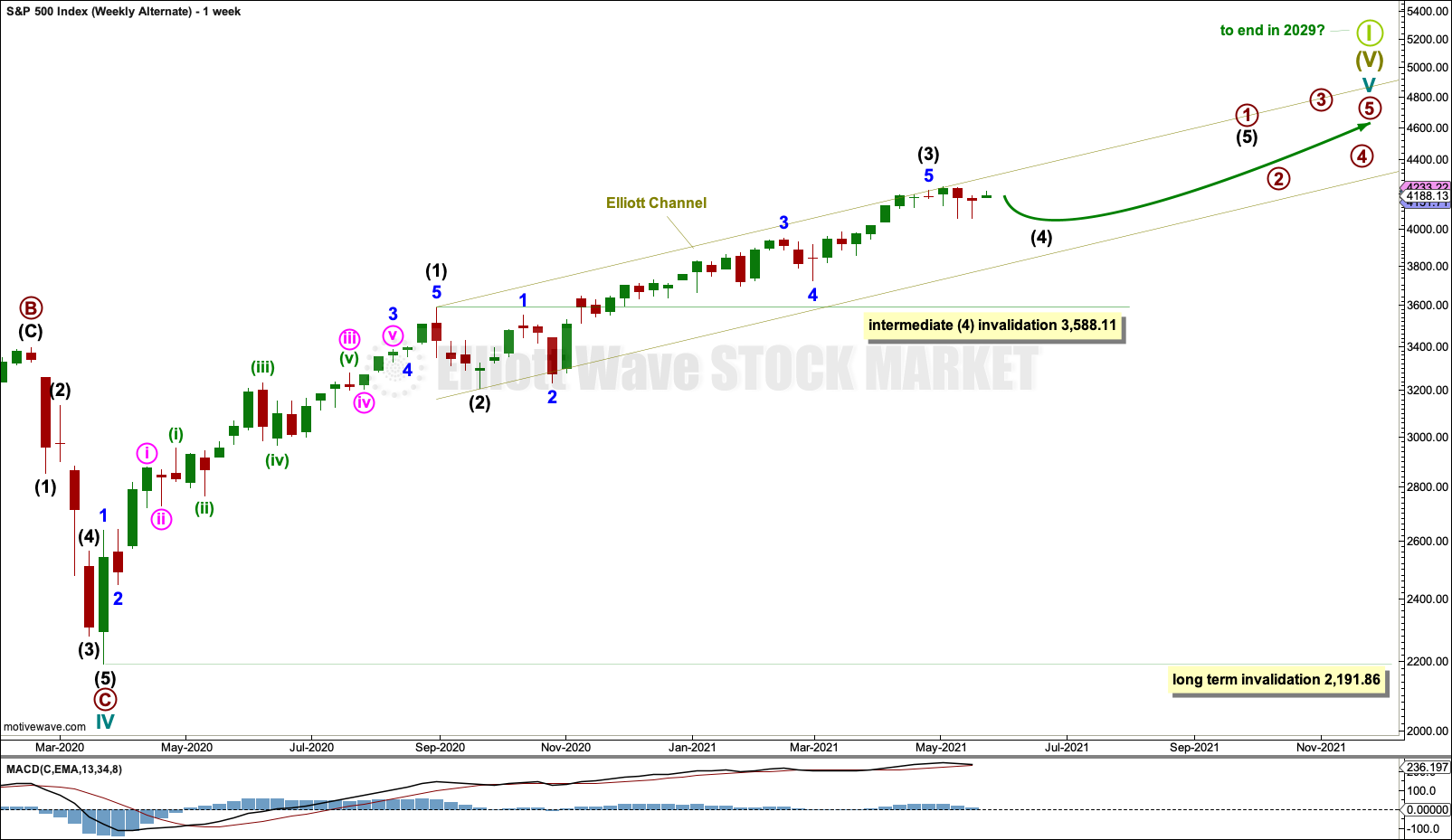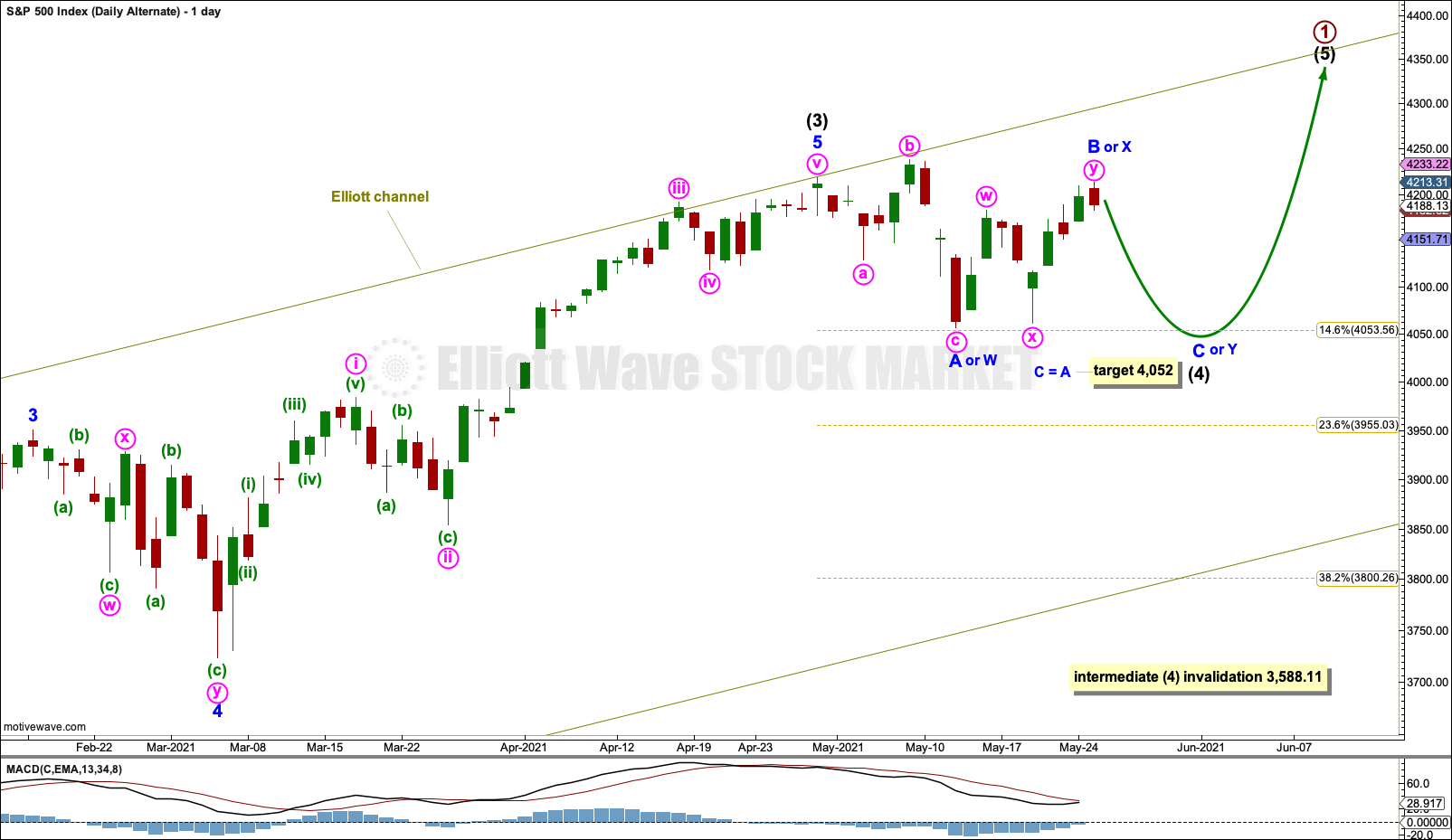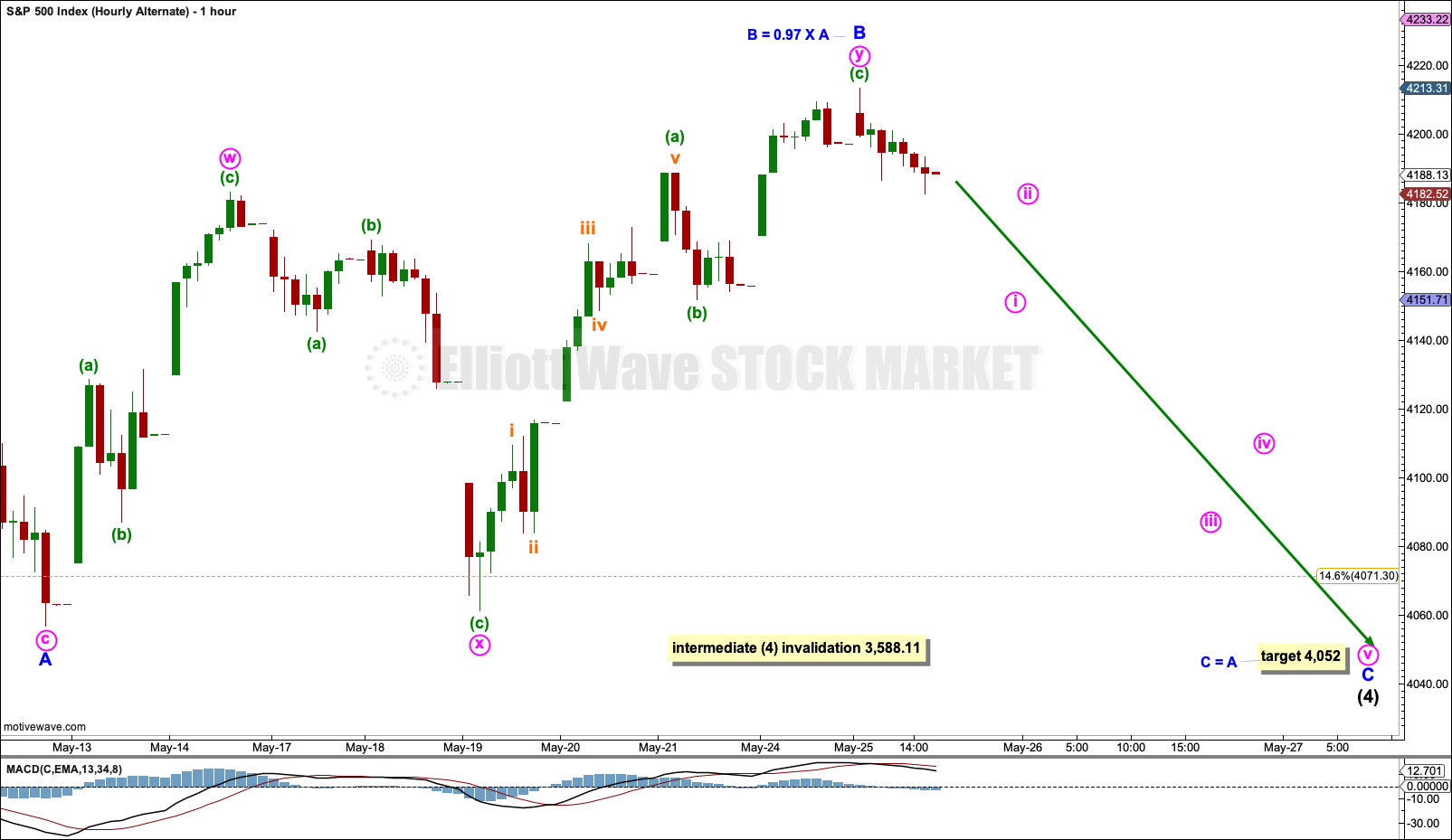S&P 500: Elliott Wave and Technical Analysis | Charts – May 25, 2021
Another upwards session with a higher high and a higher low still fits both Elliott wave counts.
Both Elliott wave counts remain valid. The main Elliott wave count still has a higher probability.
Summary: The trend is up. The next target for the next wave up is at 4,900.
An alternate Elliott wave count allows for a pullback to end slightly below 4,061.41, with a target at 4,052. It has a lower probability.
The biggest picture, Grand Super Cycle analysis, is here.
Monthly charts are last updated here with video here.
MAIN WAVE COUNT
WEEKLY CHART
Cycle wave V may last from one to several years. So far it is in its fourteenth month.
This wave count may allow time for the AD line to diverge from price as price makes final highs before the end of the bull market. The AD line most commonly diverges a minimum of 4 months prior to the end of a bull market. A longer divergence is positively correlated with a deeper bear market. A shorter divergence is positively correlated with a more shallow bear market. With zero divergence at this stage, if a surprise bear market does develop here, then it would likely be shallow.
A longer divergence between price and the AD line would be expected towards the end of Grand Super Cycle wave I.
It is possible that cycle wave V may continue until 2029, if the 2020s mirror the 1920s. Either March or October 2029 may be likely months for the bull market to end.
Cycle wave V would most likely subdivide as an impulse. But if overlapping develops, then an ending diagonal should be considered. This chart considers the more common impulse.
There is already a Fibonacci ratio between cycle waves I and III within Super Cycle wave (V). The S&P500 often exhibits a Fibonacci ratio between two of its actionary waves but rarely between all three; it is less likely that cycle wave V would exhibit a Fibonacci ratio. The target for Super Cycle wave (V) to end would best be calculated at primary degree, but that cannot be done until all of primary waves 1, 2, 3 and 4 are complete.
Primary wave 1 within cycle wave V may be incomplete. This gives a very bullish wave count, expecting a long duration for cycle wave V which has not yet passed its middle strongest portion.
Within primary wave 1: Intermediate waves (1) and (2) may be complete, and intermediate wave (3) may now be nearing an end.
Within intermediate wave (3): Minor waves 1 and 2 may be complete, and minor wave 3 may be nearing an end.
Intermediate wave (4) may not move into intermediate wave (1) price territory below 3,588.11.
An acceleration channel is drawn about cycle wave V. Draw the first trend line from the end of intermediate wave (1) to the last high, then place a parallel copy on the end of intermediate wave (2). Keep redrawing the channel as price continues higher. When primary wave 1 is complete, then this channel would be drawn using Elliott’s first technique. The channel may then be used to provide confidence that primary wave 1 may be over and primary wave 2 may have arrived; when the channel is breached by downwards movement it would indicate a trend change.
When primary wave 1 may be complete, then a multi-month pullback or consolidation may unfold for primary wave 2. It is possible that primary wave 2 may meet the technical definition of a bear market; it may correct to 20% or more of market value.
Primary wave 2 may not move beyond the start of primary wave 1 below 2,191.86.
DAILY CHART
The daily chart focusses on minor wave 3 within intermediate wave (3).
Intermediate wave (3) may be extending. Third waves are most commonly extended for the S&P500, so this wave count follows a common tendency. A target is calculated for minor wave 3, which is also expected to be extending.
If it continues lower, then minute wave iv within minor wave 3 may not move into minute wave i price territory below 3,983.87. Minute wave iv may have ended as an expanded flat.
Now that minute wave iv may be complete, as it overshot a channel drawn using Elliott’s first technique, redraw the channel now using Elliott’s second technique. Draw the first trend line from the ends of minute waves ii to iv, then place a parallel copy on the end of minute wave iii. This redrawn channel may show where minute wave v may end, either mid way within the channel or about the upper edge. It may then be used to confirm a subsequent trend change, when it is breached by downwards movement.
The channel is overshot, which for this market is acceptable, and price has moved back within the channel. This market does not always sit neatly within channels as its impulses come to an end. It is possible that as minor wave 3 ends channels may need to be redrawn.
HOURLY CHART
The target for minor wave 3 expects it to exhibit a common Fibonacci ratio to minor wave 1.
Minute wave v is expected to be a long extension. Minuette wave (i) within minute wave v may be incomplete and may be subdividing as an impulse or leading diagonal.
Within minuette wave (i): Subminuette waves i and ii may be complete, and subminuette wave iii may only subdivide as an impulse.
Within subminuette wave iii: Micro wave 1 may be complete at today’s high, and micro wave 2 may not move beyond the start of micro wave 1 below 4,061.41.
ALTERNATE WAVE COUNT
WEEKLY CHART
If this pullback is at intermediate degree, then intermediate waves (1), (2) and (3) may all be complete. Intermediate wave (3) is considerably shorter than intermediate wave (1). The S&P500 has a strong bullish bias and a tendency to exhibit extended third waves. Any wave count which expects a third wave is shorter than its counterpart first wave must necessarily have a low probability.
Intermediate wave (4) may be incomplete. It may not move into intermediate wave (1) price territory below 2,191.86.
The channel drawn about primary wave 1 is drawn using Elliott’s first technical for an impulse. Draw the first trend line from the ends of intermediate waves (1) to (3), then place a parallel copy on the end of intermediate wave (2). If intermediate wave (4) is deep, then it may find support about the lower edge of this channel.
DAILY CHART
Intermediate wave (4) may be subdividing as a regular flat. Within intermediate wave (4): Minor wave A may be a complete expanded flat, minor wave B may now be a complete double zigzag and a 0.97 length of minor wave A, indicating a regular flat, and the target for minor wave C expects it to exhibit the most common Fibonacci ratio to minor wave A.
There is no upper invalidation point for this wave count. Minor wave B may continue higher and may make a new high above the start of minor wave A as in an expanded flat. If the AD line or On Balance Volume give bullish signals, then this wave count may be discarded.
Regular flats are reasonably common structures, but within them their A waves almost always subdivide as zigzags although they may be any corrective structure except a triangle. In this example minor wave A subdivides as an expanded flat, which reduces the probability of this wave count.
Intermediate wave (4) may also be subdividing as a double combination. Minor wave W, the first structure in a double combination, may be a complete expanded flat. The double may be joined by a three in the opposite direction, a double zigzag labelled minor wave X. While X waves may subdivide as any corrective structure, they are most commonly zigzags. The possibility of a double zigzag for minor wave X reduces the probability of this wave count. Minor wave Y may now continue lower, most likely as a zigzag to end about the same level as minor wave W at 4,056.88.
If the main Elliott wave count is invalidated with a new low below 3,983.87, then this alternate may be used.
A new all time high may see this alternate Elliott wave count discarded.
HOURLY CHART
If intermediate wave (4) is continuing as a regular flat, then within it minor wave B may be complete, or it may still move higher if intermediate wave (4) subdivides as an expanded flat or combination.
Minor wave C within a flat should subdivide as a five wave structure. Minor wave C would most likely make at least a slight new low below the end of minor wave A at 4,056.88 to avoid a truncation. The target calculated would see this achieved.
If either or both the AD line and On Balance Volume provide bullish signals, then this alternate wave count may be discarded.
TECHNICAL ANALYSIS
WEEKLY CHART
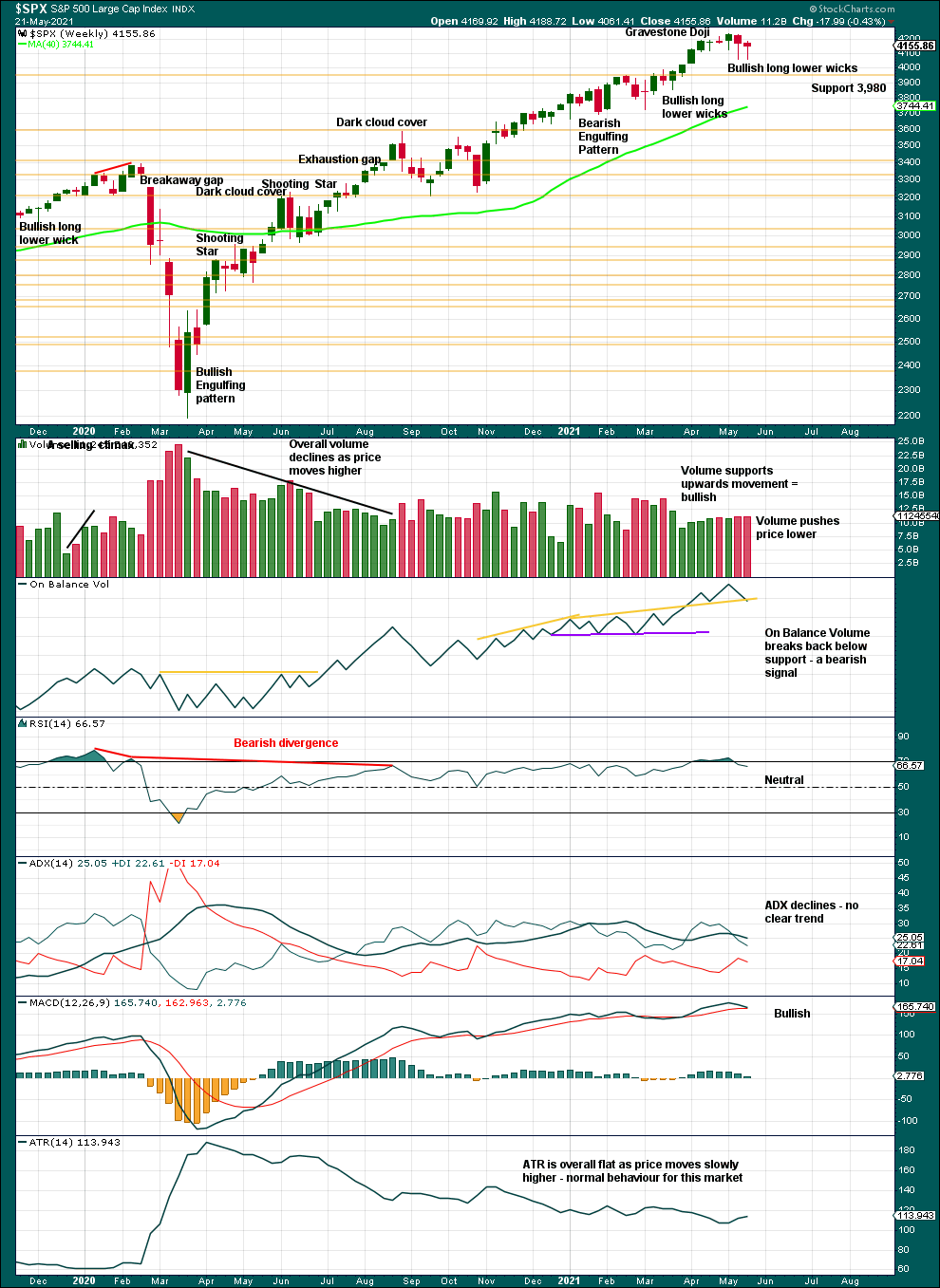
Click chart to enlarge. Chart courtesy of StockCharts.com.
A series of higher highs and higher lows off the low of March 2020 continues. The last short-term swing low is now at 3,723.34. While this remains intact, the dominant view should be of an upwards trend. There is a long way for this trend to run before conditions may become extreme.
This chart has the look of a sustainable bull market in a relatively early stage; there is as yet no evidence that a larger correction should begin here. Although RSI very recently reached overbought, this market has a strong bullish bias and RSI can move deeply overbought and remain there for years prior to the bull market ending.
Now two long lower wicks on two weekly candlesticks are bullish for the short term.
The bearish signal from On Balance Volume is not as clear as it could be. If On Balance Volume turns up this week, then the signal would be negated and the trend line would need to be redrawn. This week more weight will be given to candlestick wicks than On Balance Volume.
DAILY CHART
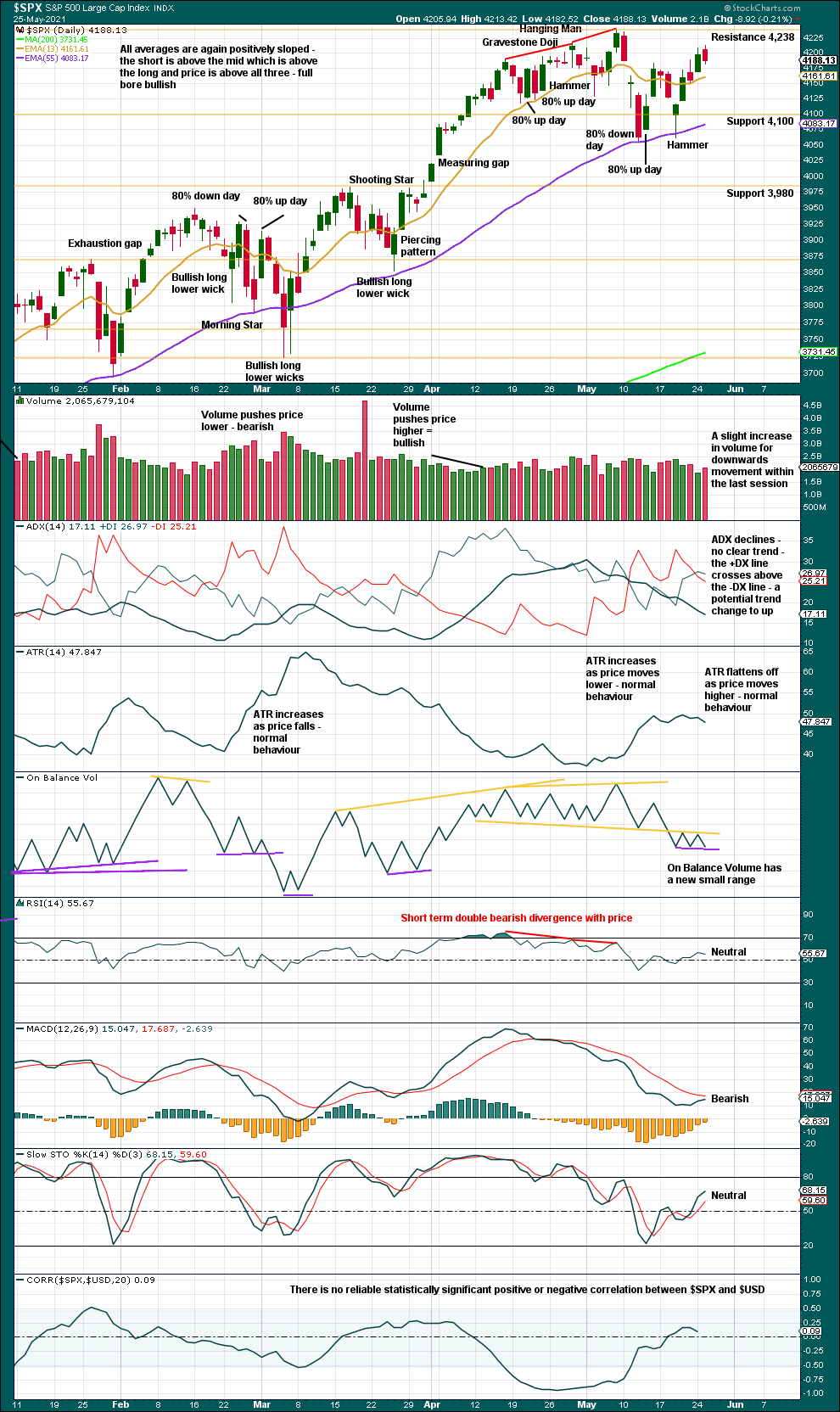
Click chart to enlarge. Chart courtesy of StockCharts.com.
The series of higher highs and higher lows from the low of the 30th of October continues.
Pullbacks are a normal and to be expected part of a bullish trend.
One strong signal of a sustainable low in place, after some decline in price, is a 90% down day or two back to back 80% down days followed within 3 or 4 sessions by a 90% up day or two back to back 80% up days. Currently, this description is not met. An 80% down day followed within a few sessions by an 80% up day is bullish, but it is not strong enough to have confidence in a sustainable low.
The decline in price down to the 12th of May may have been sufficient to resolve the double bearish divergence between price and RSI.
A bullish Hammer pattern coming after a decline on a strong downwards day is reasonably bullish. This supports the main Elliott wave count.
Price is currently consolidating with resistance about 4,238 and support about 4,057.
BREADTH – AD LINE
WEEKLY CHART
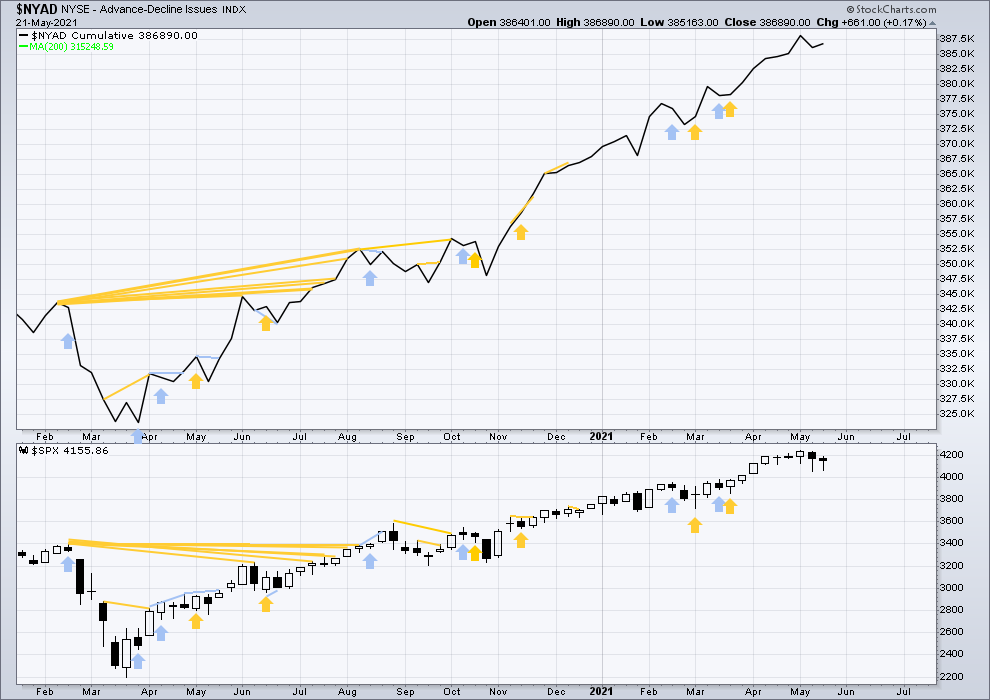
Click chart to enlarge. Chart courtesy of StockCharts.com. So that colour blind members are included, bearish signals will be noted with blue and bullish signals with yellow.
Breadth should be read as a leading indicator.
Lowry’s Operating Companies Only AD line has made a new all time high on the 7th of May. This supports the Elliott wave counts.
Large caps all time high: 4,238.04 on May 7, 2021.
Mid caps all time high: 2,778.84 on April 29, 2021.
Small caps all time high: 1,399.31 on March 12, 2021.
The last new high is found in large caps only. Small caps have been lagging since the 15th of March. Mid caps have been lagging since the 29th of April. This lag from small and mid caps is not precise in terms of timing when a pullback may begin, but it is an early warning sign of some developing weakness. It would be expected that as third waves come to an end some weakness should begin to develop; this situation may fit for either Elliott wave counts.
Price last week has moved sideways and the AD line has moved higher.
Upwards movement within last week has support from rising market breadth. This is bullish and supports the main Elliott wave count.
DAILY CHART
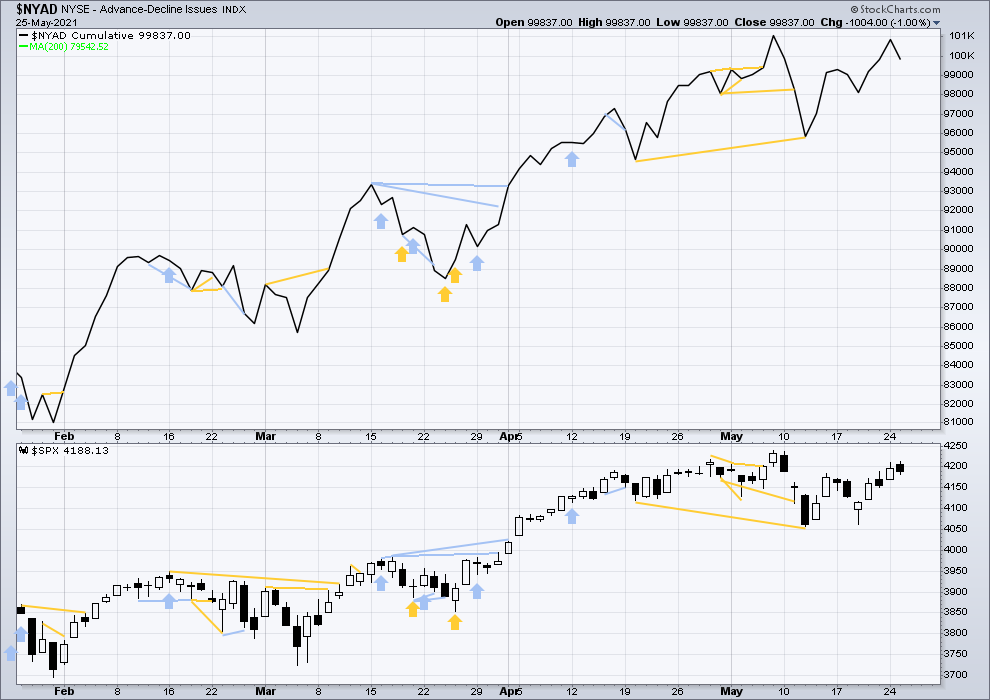
Click chart to enlarge. Chart courtesy of StockCharts.com. So that colour blind members are included, bearish signals will be noted with blue and bullish signals with yellow.
Both price and the AD line have moved lower. There is no new divergence.
There is a cluster of bullish divergence that supports the main Elliott wave count.
VOLATILITY – INVERTED VIX CHART
WEEKLY CHART
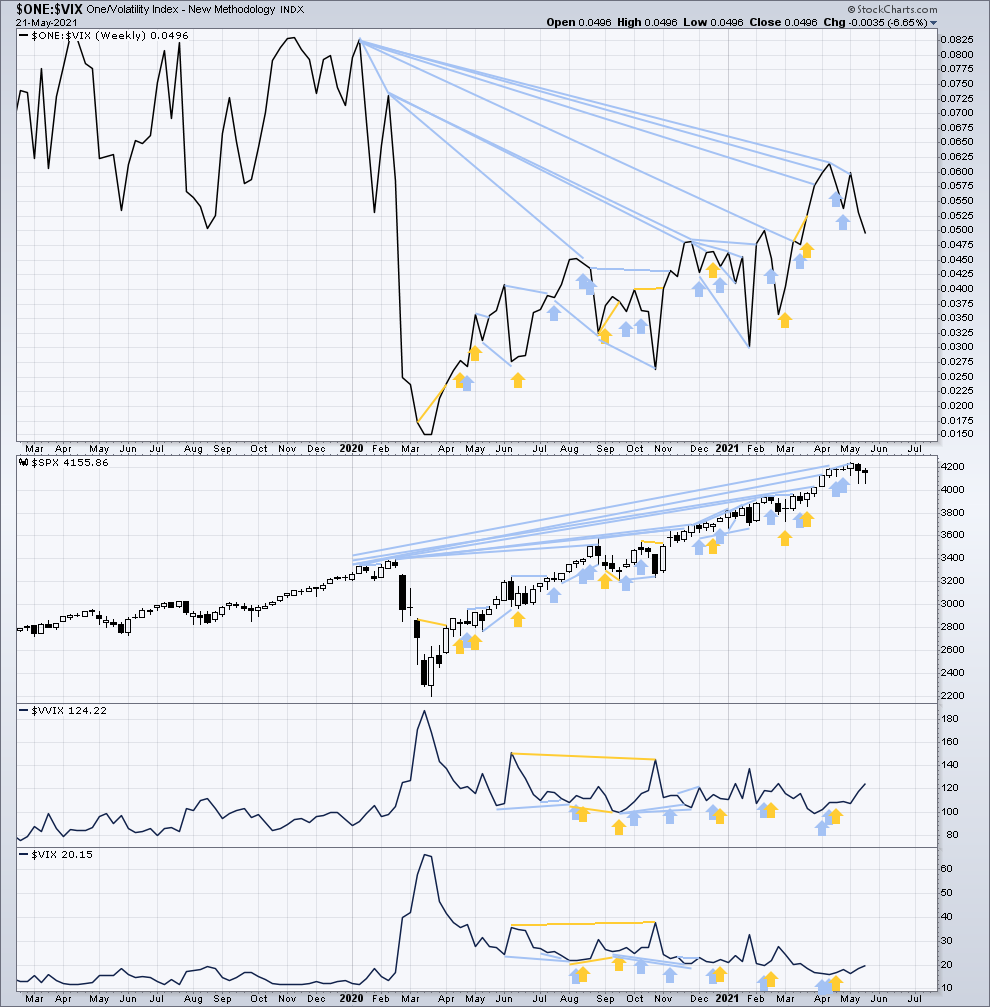
Click chart to enlarge. Chart courtesy of StockCharts.com. So that colour blind members are included, bearish signals will be noted with blue and bullish signals with yellow.
Inverted VIX remains well below all time highs. The all time high for inverted VIX was in the week beginning October 30, 2017. There is over 3 years of bearish divergence between price and inverted VIX. This bearish divergence may develop further before the bull market ends. It may be a very early indicator of an upcoming bear market, but it is not proving to be useful in timing.
Last week price has moved sideways and inverted VIX has moved lower. This is bearish for the short term.
Comparing VIX and VVIX at the weekly chart level:
Last week both VIX and VVIX have moved higher. There is no new divergence.
DAILY CHART
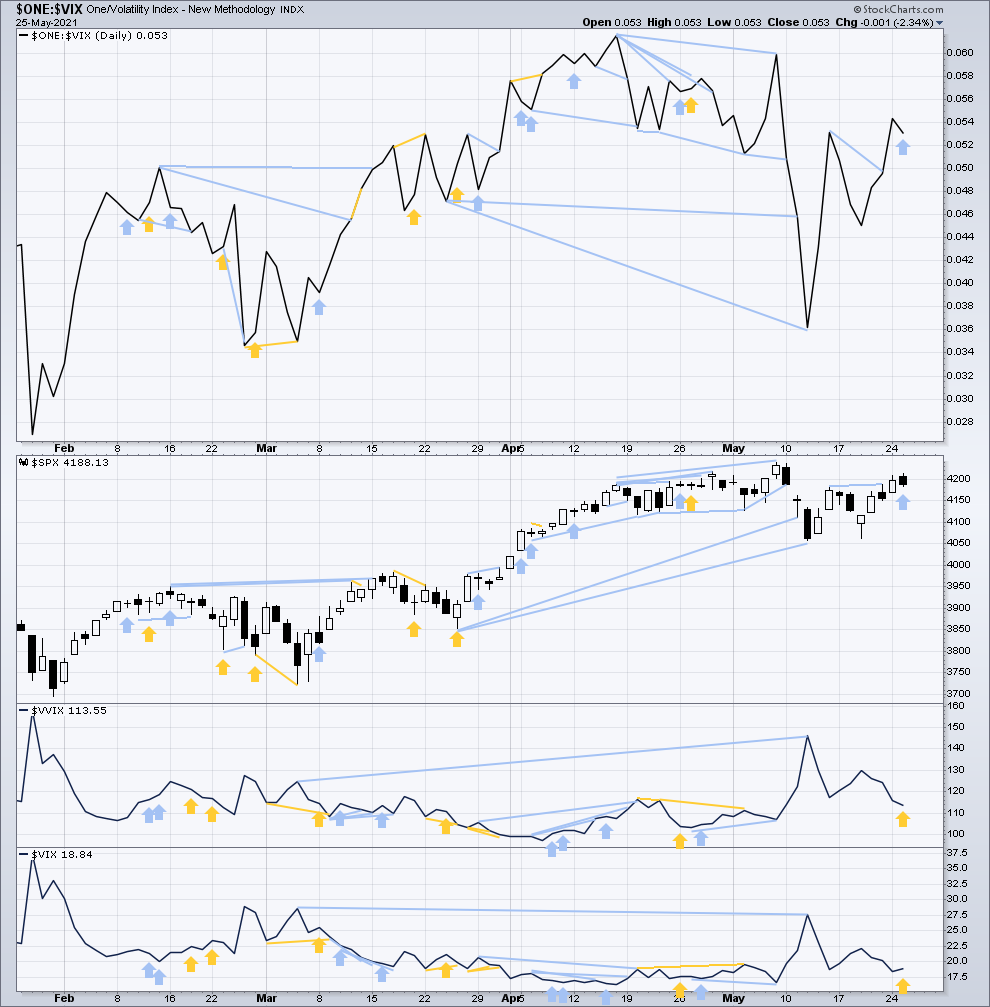
Click chart to enlarge. Chart courtesy of StockCharts.com. So that colour blind members are included, bearish signals will be noted with blue and bullish signals with yellow.
Today price has moved higher, but inverted VIX has moved lower. This divergence is bearish for the short term for price.
Comparing VIX and VVIX at the daily chart level:
Today VIX has moved higher, but VVIX has moved lower. A decline in volatility of VIX is bullish for price for the short term. This signal is bullish and contradicts the short-term divergence between price and VIX.
DOW THEORY
Dow Theory confirms a new bull market with new highs made on a closing basis:
DJIA: 29,568.57 – closed above on 16th November 2020.
DJT: 11,623.58 – closed above on 7th October 2020.
Most recently, on 10th May 2021 both DJIA and DJT have made new all time highs. An ongoing bull market is again confirmed by Dow Theory.
Adding in the S&P and Nasdaq for an extended Dow Theory, confirmation of a bull market would require new highs made on a closing basis:
S&P500: 3,393.52 – closed above on 21st August 2020.
Nasdaq: 9,838.37 – closed above on June 8, 2020.
The following major swing lows would need to be seen on a closing basis for Dow Theory to confirm a change from bull to a bear market:
DJIA: 18,213.65
DJT: 6,481.20
Adding in the S&P and Nasdaq for an extended Dow Theory, confirmation of a new bear market would require new lows on a closing basis:
S&P500: 2,191.86
Nasdaq: 6,631.42
Published @ 07:03 p.m. ET.
—
Careful risk management protects your trading account(s).
Follow my two Golden Rules:
1. Always trade with stops.
2. Risk only 1-5% of equity on any one trade.
—
New updates to this analysis are in bold.

